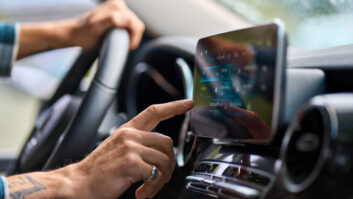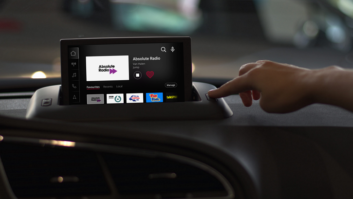 The author is chairman of Digital Radio Mondiale.
The author is chairman of Digital Radio Mondiale.
This often-rehearsed question resurfaces periodically, as radio is facing an uphill struggle against the digital giants ready to grab the dashboard. Hybrid radio is presented as a survival solution on the move, as cars remain a key driver of audio listening.
The term, meaning many things to many people, is very fashionable just now, a bit like “digital,” “convergence” and the “multimedia” mantras of some years back.
Hybrid radio is a mixture of analog radio and digital broadcast sources, like streaming, or a mash between digital radio (mainly of the local variety) and IP-served radio services.
The current orthodoxy goes that, unless good old-fashioned radio or audio also gets all the “bells and whistles” offered by known digital companies and mimics the commercial streaming services provided by the Googles of this world, radio is doomed and will be eliminated from the automotive infotainment landscape.
[Read: Hybrid Described as Radio’s Best Chance]
In the U.S. car listening remains king and accounts for more than 50% of all radio listening. According to the recently unveiled annual 2021 Techsurvey Jacobs Media and Veritone, 58% of the 40,000 U.S. respondents listen to AM/FM radio in the car, 18% to satellite radio while personal music rates some 3%. Smartphones only come in second, after cars.
But more interesting are the ranked reasons for radio’s enduring attraction: easy to listen to, familiar hosts, available for free (i.e. no money), while almost half the listeners agreed that being local is radio’s primary advantage.
Hybrid radio definitely addresses the challenge of “easy to listen to”: press a button or voice-activate your car radio and you are in business. If you leave the coverage area, an IP stream will ensure you can continue to listen to your favorite station or presenter, provided the station stream can be accessed and coordinated with the over-the-air broadcast service.
Hybrid can also paper-over the transmission gaps if your car is fitted with an analog or digital local coverage standard which is sometimes unavailable in the targeted coverage area.
And there are other positive considerations, too. Linking terrestrial broadcasting with IP ensures continuity and enhanced service, personalized and visually rich. This is all enabled by the metadata (song title, branding labels, ads, etc.) that accompany the audio on the mobile broadband connection. Above all, hybrid offers the attractive possibility of a back channel. If the hybrid receiver had, or will have in the future, an extra button for notifications: information, ads, tickets etc., these could be sent directly to your phone or email.
The two-way connectivity is the one thing radio has not been able to offer easily until now. The other is offering reliable data about who is listening to what and for how long. This is less of interest to listeners and more to advertisers and broadcasters. It is also the most valuable and remunerative information hybrid radio could provide.
[Read: Audi AG Launches Hybrid Radio in U.S. and Canada]
The proponents of hybrid radio stress that all these attributes, plus the podcasting possibility, are essential for radio’s survival and relevance on the new and flashy dashboards securing its place in the unequal battle with the apps, satellite and Big Tech services.
There are though some big caveats and questions on hybrid radio:
- Are stations prepared to foot the bill for the streaming fees linked to the smooth transitioning from terrestrial to IP, not to mention the possible copyright fees incurred while the streaming runs in the background ready to pounce only when terrestrial fails?
- Are broadcasters ready to share the streaming URLs and metadata and to make them available to open platforms or commercial entities, be they big patent companies or even car manufacturers?
- Is the provision of podcasting essential, considering that in the latest Techsurvey, 6 out of 10 U.S. radio listeners are not bothered by this hot product still not flying after 15 years, not to mention that podcasting does not enhance radio listening but possibly diminishes the radio listening time.
- If hybrid radio is the way forward, is this a U.S. and developed world project and commercial venture? According to the information released on the United Nations World Telecommunication and Information Society Day (May 17) 3.7 billion people, almost half the world population, remain unconnected to the internet.
From my own DRM perspective, the simpler question is: why hook up with IP, using extra effort and costs, analog and digital radio, when at least one digital radio standard, DRM, fulfills and satisfies already many of the aspirations of hybrid? DRM already includes SPI and what RadioDNS offers. It can connect broadcast and online, benefits from Journaline to ensure rich services, interactivity and personalized content.
A DRM receiver, in car, on a cell or in the kitchen can carry useful information: logos, maps, pictures, weather, traffic, disaster alerts and education material, addresses and ads.
DRM broadcasters can transmit on any analog frequency (AM or FM) up to three audio channels and one data channel, saving both energy, spectrum and money. One or two , or all three audio channels can be flexibly reassigned to data, so that less audio and more data is presented to users by easily programming the “four digital lanes” of DRM on one 96 kHz (FM) frequency or on an existing AM frequency. RSS feeds can be presented on DRM receivers without the need to publish and give somebody else your streaming URL and metadata information.
Does this mean that the big hybrid radio push will suddenly stop? Of course not, radio needs modern digital clothes, future proofing but also a reality check. Why reinvent the wheel when digital radio, DRM, has everything to benefit listeners and broadcasters?
If a camel is a horse designed by a committee, then hybrid is still a cute camel, not a horse yet.







